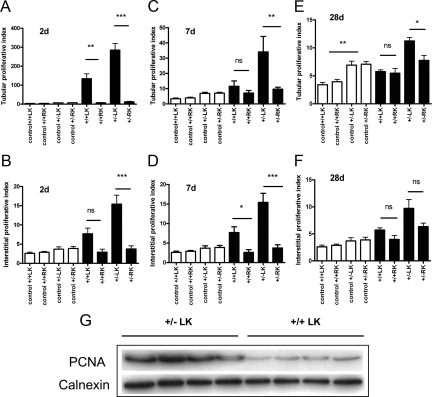Figure 1.
Proliferative responses of tubular and interstitial compartments in Pkd2 heterozygous and wild-type mice following IRI. The PI (Ki-67 positive cells per mm2) for tubular and interstitial compartments at different postreperfusion periods is shown: 2 days (A and B); 7 days (C and D); and 28 days (E and F). The contralateral RK served as a nonischemic control for the procedure. Values from control age and sex matched kidneys are shown as open bars: baseline tubular PI was twofold higher in heterozygous kidneys compared with wild type (significance only shown at 28 days for clarity). Tubular and interstitial PI were significantly higher at all time points in the injured LKs of heterozygous (+/−) and wild type (+/+) compared with control values (data not shown). In addition, values for the heterozygous LK were significantly greater than those for wild-type LK at all time points (except for interstitial PI at 7 days, P = 0.06). Data shown are means ± SEM of cell counts per mm2 per kidney (n = 5–7). ∗P < 0.05; ∗∗P < 0.01; and ∗∗∗P < 0.001. G: Mean PCNA (∼36 kDa) expression at 2 days was threefold higher in +/−LK compared with +/+LK. Calnexin (∼90 kDa) served as a control for loading and protein integrity.

